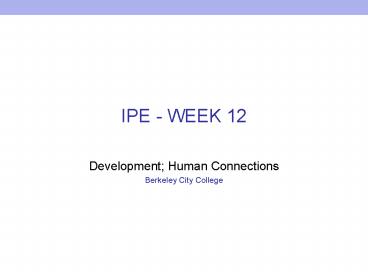IPE WEEK 12 - PowerPoint PPT Presentation
1 / 22
Title: IPE WEEK 12
1
IPE - WEEK 12
- Development Human Connections
- Berkeley City College
2
Two Faces of Development
- Loss of sovereignty
- Political
- Economic
- Loss of cultural heritage
- Exploitation by the rich nations
- Less poverty
- Improved standard of living
- Higher life expectancy
- More political power of a nation
Andre Gunder Frank on Latin America Raul
Prebisch on Latin America
3
What Shaped Development (50s-60s)?
- Colonial past
- Resistance to cultural dominance by the West
- The Cold War and proximity to the US, its allies,
or its enemies - The Norths success and the use of its model for
the South
4
Institutions and Policies of Change
- Afro-Asian Bandung Conference in Indonesia, 1955
- UNCTAD United Nations Conference on Trade and
Development, 1964 - New International Economic Order, 1974
- Commodities and prices
- Greater LDC influence in the WB and the IMF
- Better control of natural resources by LDCs
5
Strategies of Economic Development
6
Washington Consensus
- Consensus IMF WB US Treasury
- Neoliberal policies
- Free trade laissez-faire
- Free capital markets
- Risk of opening market to hot money
- Limited government intervention
- Is this the magic formula for development?
7
(No Transcript)
8
US Immigration Debate
US national income expanded by US 8B in 1997
because of immigration. The National Research
Council
9
Migration
- Driven by economic reasons, also a quest for
survival from hunger and extreme poverty. - Of the 175M international migrants today, about
86M are economically active, including migrants,
immigrant workers and refugees. - Remittances
- the portion of an international migrants
earnings sent back from a host country to the
migrants country of origin - Growing dependence of many developing countries
on the remittances of their migrant workers
abroad - The state influences migration through
immigration policy
3 of the worlds population (192M in 05) 9 of
the developed world (104M) 12 of the US (gt39M)
10
Migrant Population
11
Inflows and Outflows Emigration vs. Immigration
12
Female Migrants
13
Foreign Students in Higher Ed
14
IPE Views on Migration
- Mercantilists
- Focus on effects of migration on national
interest - Loss of jobs for domestic workers
- Migrants as security threat
- Liberals
- Freedom of movement, liberty, and human rights
- Positive economic effects benefits to migrants
and hosting country - Structuralists
- Focus only on temporary migrant flows
- Exploitation of the periphery by the core
- Abuse of human rights
- Lack of legal protection
- Brain drain issue
15
Remittances
- Official global remittance flows at US93B in
03, gtUS100B in 04 - Total global remittances - US100B annually
- Remittance flows gt official aid flows flows to
developing countries - - comparable to FDIs and world petroleum export
earnings - Davesh Kapurs (2003) five interesting features
of remittances today - Significant stable source of external
development finance - Flow to developing countries of all income levels
- A stable source of financial flows for nations in
crisis - The main source of income, in addition to
tourism, for people in small island economies - Self-help remedy
16
Remittances vs. Foreign Aid
17
Remittances as the New Development Mantra
- Remittances and Poverty Reduction
- WB reports in a study of 74 low and middle income
countries on the average, a 10 increase in the
number of international migrants in a country's
population can lead to a 1.6 decline in poverty
headcount. - Same WB report also says that a 10 in the share
of remittances in a countrys GDP can lead to a
1.2 decline in poverty. - At community and family level
- Remittances towards basic social spending, e.g.
nutrition, health care, housing, clothing, and
education. - Remittances as investments in community
development projects and social infrastructures - Emerging role of NGOs and migrant networks, i.e.
MSAI Model Migrants Savings for Alternative
Investments Model
18
Remittances to Africa
19
Remittances to Latin America
20
Remittances to Asia
21
Human Networks
- Networks
- Adaptive and volatile structures and functions
- Multiple lines of communications
- Types of networks
- Diasporas
- Jewish
- Chinese
- Ethiopian
- Terrorist networks
- Hawala
- Informal finance network from the Middle Ages
- Hawaladar agent, 5 commission
- International ATM with its password
- Deriving trust from kinship, ethnic relations, or
personal ties
22
Discussion Q
- Globalization is a network of networks.
- (M. Veseth)
- In what way does globalization connect people?
What are the connecting points? - In what ways does it disconnect people, thus
contributing to a paradox about globalization and
more narrower networks?































